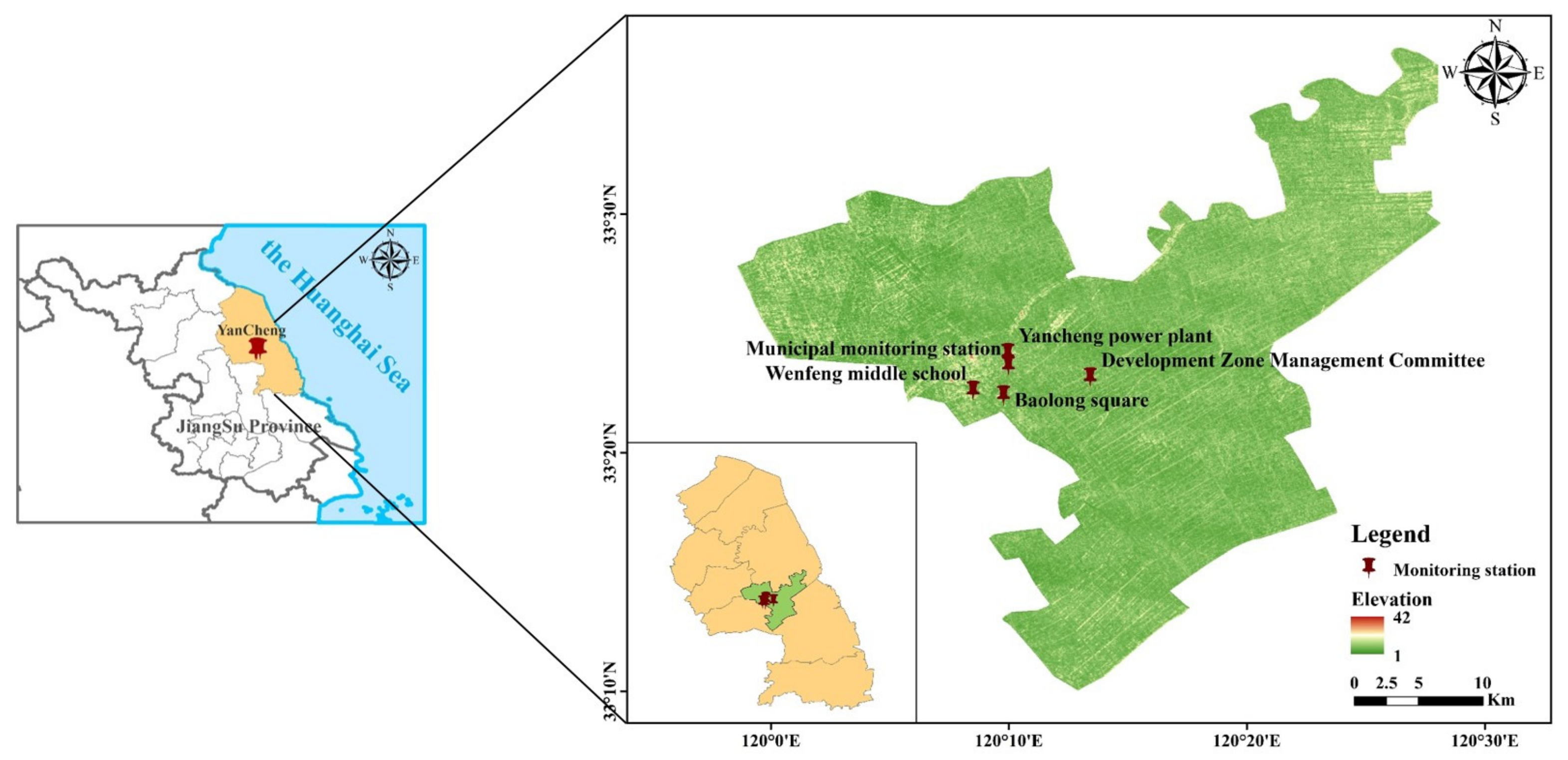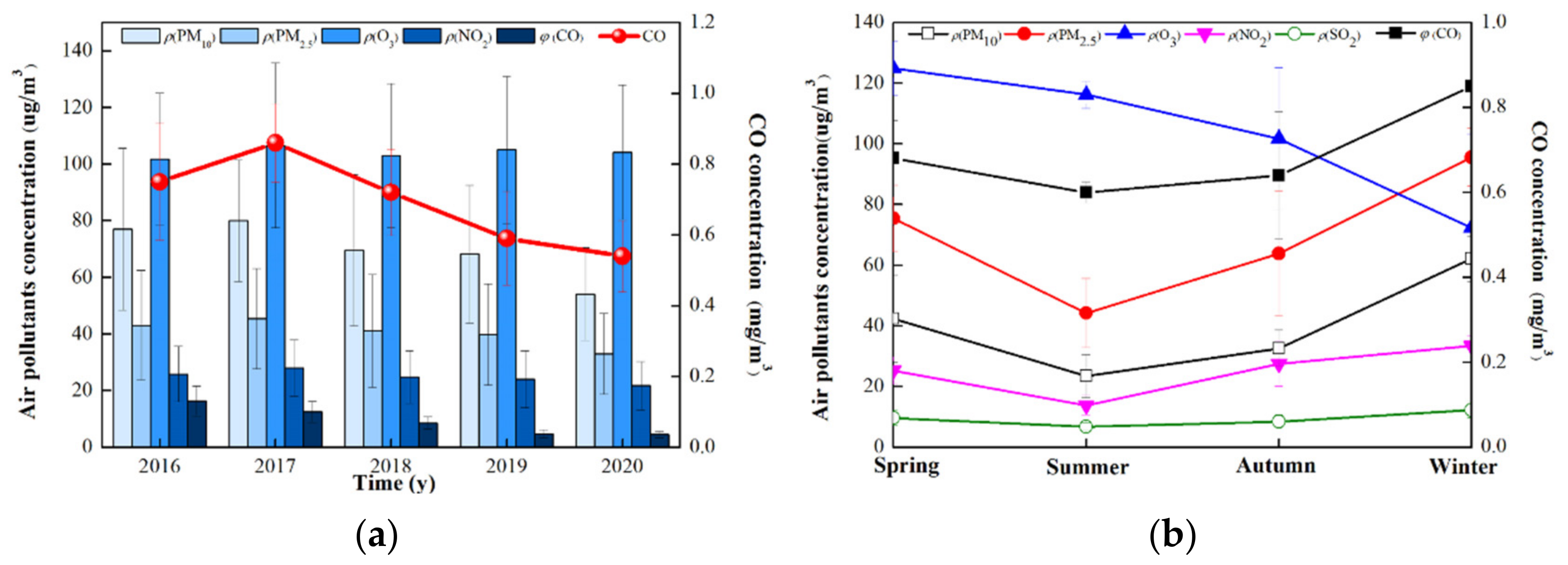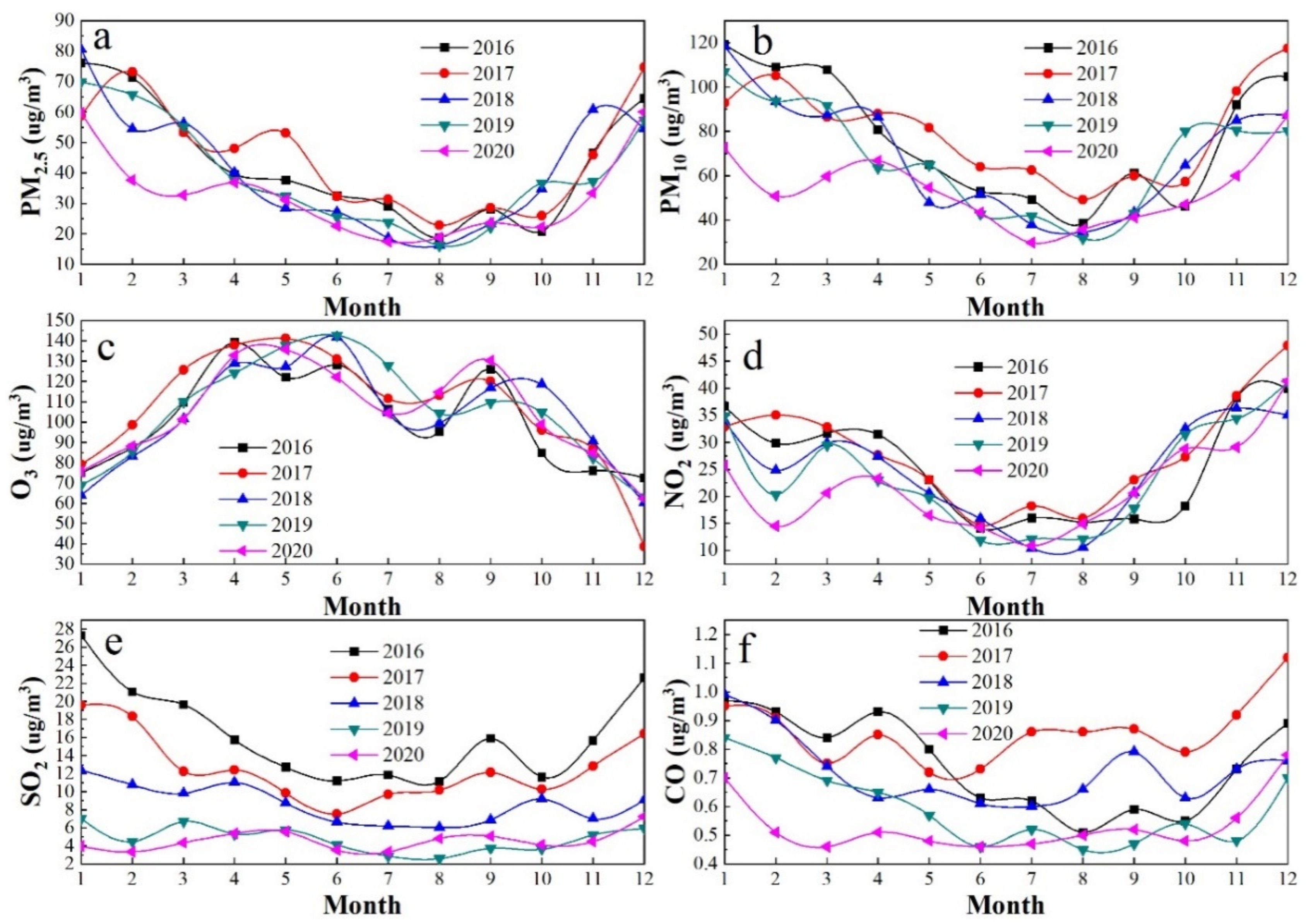Spatiotemporal Assessment of Atmospheric Pollutants in Yancheng City, Eastern Coastal City of China
Abstract
1. Introduction
2. Materials and Methods
2.1. Sampling Locations
2.2. Analytical Methods
3. Results
3.1. Overview of Air Quality in the Urban Area of Yancheng
3.2. Interannual and Seasonal Characteristics of Air Pollutant Concentrations
3.3. Monthly Variation of Air Pollutant Concentrations
3.4. Daily Variation of Air Pollutant Concentrations
3.5. Weekend Effect in Air Pollution Concentration
3.6. Relationship between Atmospheric Pollutants and Meteorology
4. Conclusions
Author Contributions
Funding
Institutional Review Board Statement
Informed Consent Statement
Data Availability Statement
Conflicts of Interest
References
- Faridi, S.; Krzyzanowski, M.; Cohen, A.J.; Malkawi, M.; Safi, H.A.M.; Yousefian, F.; Azimi, F.; Naddafi, K.; Momeniha, F.; Niazi, S.; et al. Ambient Air Quality Standards and Policies in Eastern Mediterranean Countries: A Review. Int. J. Public Health 2023, 68, 1605352. [Google Scholar] [CrossRef] [PubMed]
- Duarte, A.L.; Schneider, I.L.; Artaxo, P.; Oliveira, M.L.S. Spatiotemporal assessment of particulate matter (PM10 and PM2.5) and ozone in a Caribbean urban coastal city. Geosci. Front. 2022, 13, 101168. [Google Scholar] [CrossRef]
- de Hoogh, K.; Chen, J.; Gulliver, J.; Hoffmann, B.; Hertel, O.; Ketzel, M.; Bauwelinck, M.; van Donkelaar, A.; Hvidtfeldt, U.A.; Katsouyanni, K.; et al. Spatial PM2.5, NO2, O3 and BC models for Western Europe-Evaluation of spatiotemporal stability. Environ. Int. 2018, 120, 81–92. [Google Scholar] [CrossRef] [PubMed]
- Wang, H.B.; Zhao, L.J. A joint prevention and control mechanism for air pollution in the Beijing-Tianjin-Hebei region in China based on long-term and massive data mining of pollutant concentration. Atmos. Environ. 2018, 174, 25–42. [Google Scholar] [CrossRef]
- Wang, B.N.; Luo, X.C.; Liu, D.Y.; Su, Y.; Wu, Z.Y. The effect of construction dust and agricultural fertilization on the precipitation chemical composition during summer in the Yangtze River Delta area, China. Atmos. Pollut. Res. 2021, 12, 101121. [Google Scholar] [CrossRef]
- Heroux, M.E.; Anderson, H.R.; Atkinson, R.; Brunekreef, B.; Cohen, A.; Forastiere, F.; Hurley, F.; Katsouyanni, K.; Krewski, D.; Krzyzanowski, M.; et al. Quantifying the health impacts of ambient air pollutants: Recommendations of a WHO/Europe project. Int. J. Public Health 2015, 60, 619–627. [Google Scholar] [CrossRef]
- Zhao, P.S.; Dong, F.; He, D.; Zhao, X.J.; Zhang, X.L.; Zhang, W.Z.; Yao, Q.; Liu, H.Y. Characteristics of concentrations and chemical compositions for PM2.5 in the region of Beijing, Tianjin, and Hebei, China. Atmos. Chem. Phys. 2013, 13, 4631–4644. [Google Scholar] [CrossRef]
- Song, Y.; Wang, X.; Maher, B.A.; Li, F.; Xu, C.; Liu, X.; Sun, X.; Zhang, Z. The spatial-temporal characteristics and health impacts of ambient fine particulate matter in China. J. Clean. Prod. 2016, 112, 1312–1318. [Google Scholar] [CrossRef]
- Zhang, R.H.; Li, Q.; Zhang, R.N. Meteorological conditions for the persistent severe fog and haze event over eastern China in January 2013. Sci. China-Earth Sci. 2014, 57, 26–35. [Google Scholar]
- Zhang, X.L.; Shi, M.J.; Li, Y.J.; Pang, R.; Xiang, N. Correlating PM2.5 concentrations with air pollutant emissions: A longitudinal study of the Beijing-Tianjin-Hebei region. J. Clean. Prod. 2018, 179, 103–113. [Google Scholar] [CrossRef]
- Xu, G.Y.; Ren, X.D.; Xiong, K.N.; Li, L.Q.; Bi, X.C.; Wu, Q.L. Analysis of the driving factors of PM2.5 concentration in the air: A case study of the Yangtze River Delta, China. Ecol. Indic. 2020, 110, 105889. [Google Scholar] [CrossRef]
- Wang, B.N.; Pu, M.J.; Chen, P.; Sun, M. Characteristic Analysis of Atmospheric Pollutants in Nanjing Urban Area in Winter. Res. Environ. Sci. 2017, 30, 1335–1345. [Google Scholar]
- Wang, X.Y.; Jiang, F.; Xu, S.C.; Tian, X.D.; Yao, D.F. Assessment of Emergency Emission Reduction Effect during a Severe Air Pollution Episode in Yangtze River Delta Region. Res. Environ. Sci. 2020, 33, 783–791. [Google Scholar]
- Liu, W.W.; Duan, J.C.; Hu, J.N.; Yin, L.N.; Hu, B.X.; Yang, C.; Yu, R. Effect Assessment of Emergency Measures for Heavy Air Pollution based on Environmental Monitoring Data. Res. Environ. Sci. 2019, 32, 734–741. [Google Scholar]
- Song, C.; Wu, L.; Xie, Y.; He, J.; Chen, X.; Wang, T.; Lin, Y.; Jin, T.; Wang, A.; Liu, Y.; et al. Air pollution in China: Status and spatiotemporal variations. Environ. Pollut. 2017, 227, 334–347. [Google Scholar] [CrossRef]
- Wang, Y.; Konopka, P.; Liu, Y.; Chen, H.; Mueller, R.; Ploeger, F.; Riese, M.; Cai, Z.; Lu, D. Tropospheric ozone trend over Beijing from 2002–2010: Ozonesonde measurements and modeling analysis. Atmos. Chem. Phys. 2012, 12, 8389–8399. [Google Scholar] [CrossRef]
- Xiao, K.; Wang, Y.K.; Wu, G.; Fu, B.; Zhu, Y.Y. Spatiotemporal Characteristics of Air Pollutants (PM10, PM2.5, SO2, NO2, O3, and CO) in the Inland Basin City of Chengdu, Southwest China. Atmosphere 2018, 9, 74. [Google Scholar] [CrossRef]
- Duan, W.J.; Wang, C.; Pei, N.C.; Zhang, C.; Gu, L.; Jiang, S.S.; Hao, Z.Z.; Xu, X.H. Spatiotemporal Ozone Level Variation in Urban Forests in Shenzhen, China. Forests 2019, 10, 247. [Google Scholar] [CrossRef]
- Li, H.; Wang, S.L.; Zhang, W.J.; Wang, H.; Han Wang, H.; Wang, S.B.; Li, H.S. Characteristics and Influencing Factors of Urban Air Quality in Beijing-Tianjin-Hebei and Its Surrounding Areas (2+26’Cities). Res. Environ. Sci. 2021, 34, 172–184. [Google Scholar]
- Song, W.; Chang, Y.H.; Liu, X.J.; Li, K.H.; Gong, Y.M.; He, G.X.; Wang, X.L.; Christie, P.; Zheng, M.; Dore, A.J. A Multiyear Assessment of Air Quality Benefits from China’s Emerging Shale Gas Revolution: Urumqi as a Case Study. Environ. Sci. Technol. 2015, 49, 2066–2072. [Google Scholar] [CrossRef]
- Lai, L.W. The relationship between typhoon features and fine particulate matter: Events in Metropolitan Taipei. Theor. Appl. Climatol. 2020, 139, 127–143. [Google Scholar] [CrossRef]
- Rohit Jaikumar, R.; Nagendra, S.M.S.; Sivanandan, R. Modeling of real time exhaust emissions of passenger cars under heterogeneous traffic conditions. Atmos. Pollut. Res. 2017, 8, 80–88. [Google Scholar] [CrossRef]
- Hu, J.L.; Wu, L.; Zheng, B.; Zhang, Q.; He, K.B.; Chang, Q.; Li, X.H.; Yang, F.M.; Ying, Q.; Zhang, H.L. Source contributions and regional transport of primary particulate matter in China. Environ. Pollut. 2015, 207, 31–42. [Google Scholar] [CrossRef] [PubMed]
- Wang, X.; Song, G.H.; Wu, Y.Z.; Yu, L.; Zhai, Z.Q. A NOx Emission Model Incorporating Temperature for Heavy-Duty Diesel Vehicles with Urea-SCR Systems Based on Field Operating Modes. Atmosphere 2019, 10, 337. [Google Scholar] [CrossRef]
- Zhu, L.; Gan, Q.M.; Liu, Y.; Yan, Z.J. The impact of foreign direct investment on SO2 emissions in the Beijing-Tianjin-Hebei region: A spatial econometric analysis. J. Clean. Prod. 2017, 166, 189–196. [Google Scholar] [CrossRef]
- Menezes, D.L.A.; Bannwart, E.S.; De Souza, J.E.; Rojas, S.S. Thermoluminescence emission on lead oxychloroborate glasses under UV exposure. Luminescence 2019, 34, 918–923. [Google Scholar] [CrossRef]
- Gadzhiev, I.S. The method for measuring of daily dynamics of variation of O3 and NO2 concentrations along roadways. Sens. Syst. 2013, 2, 43–45. [Google Scholar]
- Li, K.L.; Wang, H.; Chen, L.C.; Li, J.Y.; Dong, F. Synergistic degradation of NO and C7H8 for inhibition of O3 generation. Appl. Catal. B Environ. 2022, 312, 121423. [Google Scholar] [CrossRef]
- Qin, D.S.; Gao, C.Y. Control Measures for Automobile Exhaust Emissions in PM2.5 Governance. Discret. Dyn. Nat. Soc. 2022, 2022, 8461406. [Google Scholar] [CrossRef]
- Burnett, R.T.; Cakmak, S.; Raizenne, M.E.; Stieb, D.; Vincent, R.; Krewski, D.; Brook, J.R.; Philips, O.; Ozkaynak, H. The association between ambient carbon monoxide levels and daily mortality in Toronto, Canada. J. Air Waste Manag. Assoc. 1998, 48, 689–700. [Google Scholar] [CrossRef]
- Hasanayn, F.; Abu-El-Ez, D. Calculation of Dramatic Differences in the Activation Energy of Phenyl Migratory Insertion in the Isomers of [Rh(PMe3)(2)CI(CO)(Ph)H]: Important Effects from Both the Ligand trans to Ph and the Ligand trans to CO. Inorg. Chem. 2010, 49, 9162–9168. [Google Scholar] [CrossRef] [PubMed]
- Elansky, N.F.; Shilkin, A.V.; Ponomarev, N.A.; Semutnikova, E.G.; Zakharova, P.V. Weekly patterns and weekend effects of air pollution in the Moscow megacity. Atmos. Environ. 2020, 224, 117303. [Google Scholar] [CrossRef]
- Chen, Y.; Tian, M.; Huang, R.J.; Shi, G.M.; Wang, H.B.; Peng, C.; Cao, J.J.; Wang, Q.Y.; Zhang, S.M.; Guo, D.M.; et al. Characterization of urban amine-containing particles in southwestern China: Seasonal variation, source, and processing. Atmos. Chem. Phys. 2019, 19, 3245–3255. [Google Scholar] [CrossRef]
- Gong, Y.L.; Luo, X.Y. Design of Dynamic Diffusion Simulation System for Atmospheric Pollutants in Coastal Cities under Persistent Inverse Temperature. J. Coast. Res. 2020, 103, 526–529. [Google Scholar] [CrossRef]
- Sun, X.Y.; Zhou, Y.; Zhao, T.L.; Bai, Y.Q.; Huo, T.; Leng, L.; He, H.; Sun, J. Effect of Vertical Wind Shear on PM2.5 Changes over a Receptor Region in Central China. Remote Sens. 2022, 14, 3333. [Google Scholar] [CrossRef]
- Mi, K.; Zhuang, R.; Zhang, Z.; Gao, J.; Pei, Q. Spatiotemporal characteristics of PM2.5 and its associated gas pollutants, a case in China. Sustain. Cities Soc. 2019, 45, 287–295. [Google Scholar] [CrossRef]








Disclaimer/Publisher’s Note: The statements, opinions and data contained in all publications are solely those of the individual author(s) and contributor(s) and not of MDPI and/or the editor(s). MDPI and/or the editor(s) disclaim responsibility for any injury to people or property resulting from any ideas, methods, instructions or products referred to in the content. |
© 2023 by the authors. Licensee MDPI, Basel, Switzerland. This article is an open access article distributed under the terms and conditions of the Creative Commons Attribution (CC BY) license (https://creativecommons.org/licenses/by/4.0/).
Share and Cite
Wang, B.; Zhang, C.; Huang, L.; Zhang, G.; Yuan, X.; Yao, R.; Zhang, M. Spatiotemporal Assessment of Atmospheric Pollutants in Yancheng City, Eastern Coastal City of China. Atmosphere 2023, 14, 851. https://doi.org/10.3390/atmos14050851
Wang B, Zhang C, Huang L, Zhang G, Yuan X, Yao R, Zhang M. Spatiotemporal Assessment of Atmospheric Pollutants in Yancheng City, Eastern Coastal City of China. Atmosphere. 2023; 14(5):851. https://doi.org/10.3390/atmos14050851
Chicago/Turabian StyleWang, Boni, Chunting Zhang, Liang Huang, Gu Zhang, Xinyi Yuan, Ruan Yao, and Min Zhang. 2023. "Spatiotemporal Assessment of Atmospheric Pollutants in Yancheng City, Eastern Coastal City of China" Atmosphere 14, no. 5: 851. https://doi.org/10.3390/atmos14050851
APA StyleWang, B., Zhang, C., Huang, L., Zhang, G., Yuan, X., Yao, R., & Zhang, M. (2023). Spatiotemporal Assessment of Atmospheric Pollutants in Yancheng City, Eastern Coastal City of China. Atmosphere, 14(5), 851. https://doi.org/10.3390/atmos14050851




